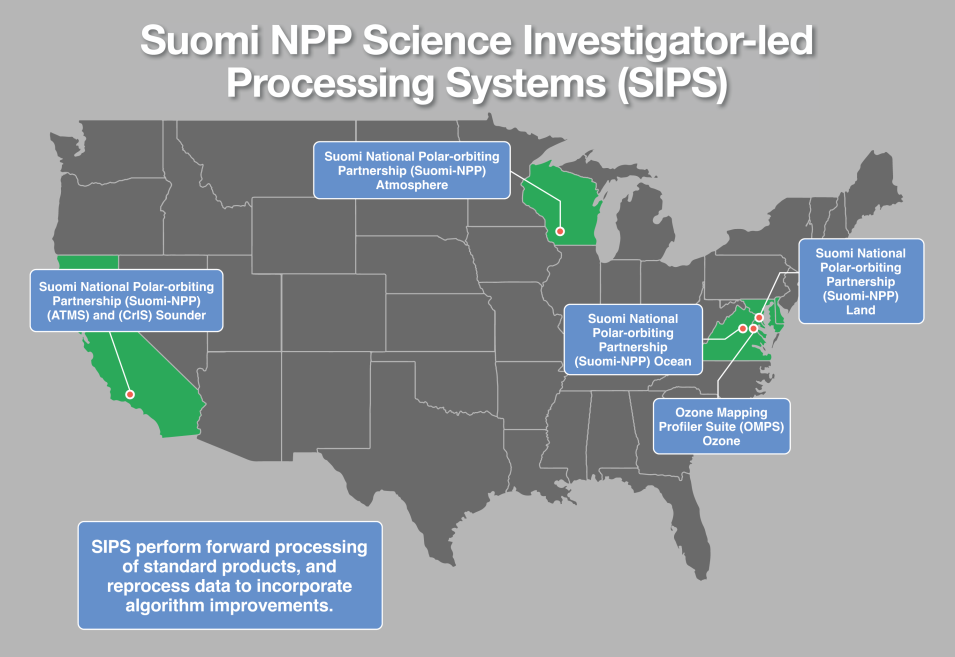The joint NASA-NOAA Suomi National Polar-orbiting Partnership (Suomi NPP) satellite launched into space on October 28, 2011. Designed as a bridge mission to provide continuity between NASA’s Earth Observation System (EOS) satellites and the next-generation spacecraft of the Joint Polar Satellite System (JPSS), Suomi NPP’s successful entry into low Earth orbit paved the way for the launch of NOAA-20 (formerly JPSS-1) on November 18, 2017, and JPSS-2, which rocketed into space November 10, 2022, and will be known as NOAA-21.
Like their EOS predecessors, JPSS satellites collect critical meteorological data for short-term, seasonal, and long-term forecasting; global measurements of atmospheric, oceanic, and terrestrial conditions; and extend the multidecade data records that enable the study of long-term climate trends.
As the first JPSS satellite, Suomi NPP provided nearly an order of magnitude more data than the spacecraft of the EOS system. It also gave NASA and its partner agencies access to and experience with the JPSS' latest and most advanced sensors, thereby facilitating the data continuity efforts associated with the transition from NASA's EOS. In addition, working with Suomi NPP also gave scientists and engineers an opportunity to test the operations systems on the ground and validate sensors and algorithms while the technologies of the current system were still in place.
As part of the efforts to validate those new sensors and the algorithms that interpret the data they provide, NASA's Earth Science Data and Information System (ESDIS) Project supports five Science Investigator-led Processing Systems (SIPS), which are responsible for producing, assessing, processing, and reprocessing products from Suomi NPP's instruments: the Advanced Technology Microwave Sounder (ATMS), the Clouds and the Earth's Radiant Energy System (CERES), the Cross-Track Infrared Sounder (CrIS), the Ozone Mapping and Profiler Suite (OMPS), and the Visible Infrared Imaging Radiometer Suite (VIIRS).
Over the years, the SIPS' work has helped NASA and NOAA meet the goals of the Suomi NPP mission and benefitted long-term studies of global change.
"The Suomi NPP SIPS are responsible for processing and reprocessing data products," said Evelyn Ho, SIPS Manager for ESDIS. "They work very closely with the Principal Investigators (PIs) and science team leads (TLs), who develop the algorithms, in testing the updated algorithm in a production-like environment and generating test datasets for evaluation to ensure it produces consistent and good quality data."
Like all NASA SIPS, the Suomi NPP SIPS are geographically distributed across the United States and are generally (but not always) collocated with the Science Computing Facilities (SCFs) that process data from a specific instrument or mission. When a new or reprocessed data product is ready for release, the SIPS sends it to the appropriate NASA Distributed Active Archive Center (DAAC) for archiving and distribution. Thanks to the SIPS, data users have more than 10,000 unique data products that are constantly reprocessed and improved to provide the best research-caliber data possible.
NASA's five Suomi NPP SIPS are:
- The Atmosphere SIPS is responsible for the production, processing, reprocessing, and general assessment of Suomi NPP VIIRS Atmosphere Products. It delivers its data products along with scientific algorithm software, associated metadata, and documentation to NASA's Level 1 and Atmosphere Archive and Distribution System DAAC (LAADS DAAC) via the Land SIPS, the Goddard Earth Sciences Data Information Services Center (GES DISC), the Atmospheric Science Data Center (ASDC), and NASA's Land, Atmosphere Near real-time Capability for EOS (LANCE).
- The Land SIPS is responsible for the production, processing, reprocessing, and general assessment of the Suomi NPP Science Team standard and experimental VIIRS Land Products. It delivers its data products along with the scientific algorithm software, associated metadata, and documentation to NASA's LAADS DAAC, National Snow and Ice Data Center DAAC (NSIDC DAAC), and Land Processes DAAC (LP DAAC).
- The Ocean SIPS is responsible for producing, processing, reprocessing, and general assessments of Suomi NPP VIIRS Ocean Products. It delivers its data products along with scientific algorithm software, associated metadata, and documentation to NASA's Ocean Biology DAAC (OB.DAAC).
- The Ozone SIPS is responsible for processing and reprocessing Suomi NPP OMPS Nadir and Limb products. It delivers its data products along with scientific algorithm software, associated metadata, and documentation to the OMPS website and GES DISC.
- The Sounder SIPS is responsible for the production, processing, and reprocessing of data products from Suomi NPP's ATMS and CrIS, which are collectively referred to as the Cross-track Infrared and Microwave Sounding Suite (CrIMSS). It too delivers its data products along with scientific algorithm software, associated metadata, and documentation to GES DISC.


